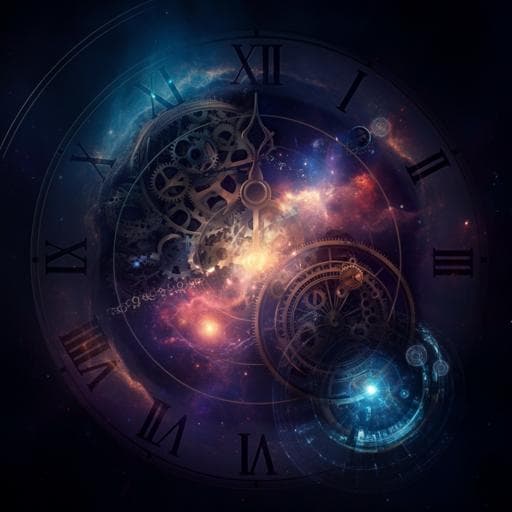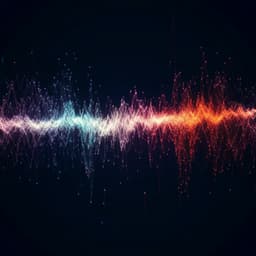
Physics
A single atom noise probe operating beyond the Heisenberg limit
T. Dutta and M. Mukherjee
This groundbreaking research by T. Dutta and M. Mukherjee showcases a frequency measurement technique that not only surpasses the Heisenberg limit but also offers enhanced precision in noise frequency measurements in the kHz range. Their innovative approach opens up new possibilities for detecting light mass axion-like dark matter particles.
~3 min • Beginner • English
Introduction
The study addresses how precisely frequency can be estimated when the system Hamiltonian is time-dependent. Conventional frequency metrology compares a laser’s phase to that of an isolated two-level atom, yielding precision that scales inversely with observation time T under time-independent dynamics (Ramsey scheme), bounded by the Heisenberg limit. Real experiments face systematic and statistical uncertainties; the latter can be reduced by averaging and longer observation time. The work explores surpassing the 1/T Heisenberg scaling for single-probe metrology by employing coherent adaptive control for time-dependent Hamiltonians, enabling faster phase information acquisition. While not applicable to atomic clocks (time-independent frequency), the protocol targets noise frequency estimation on a clock transition with substantially higher precision, motivating applications such as direct searches for time-varying interactions from axion-like dark matter (ALPs).
Literature Review
The authors frame parameter estimation within the Cramér-Rao bound and quantum Fisher information (QFI), noting that for time-independent Hamiltonians U = exp(-i α H t) the QFI scales as T^2, yielding 1/T uncertainty, and that entanglement can surpass the shot-noise limit for multiple probes. Nonlinear metrological schemes can formally beat Heisenberg scaling but fall outside the strict linear-response Heisenberg limit; trapped-ion and single-spin spectrum analyzers have demonstrated nonlinear response. For time-dependent Hamiltonians, Pang and collaborators proposed adaptive control achieving precision beyond the Heisenberg limit even in linear response, with demonstrations including 1/T^(3/2) scaling in NV centers and claims of 1/T^2 using adaptive control in superconducting qubits (limited to >1 MHz). Significant 1/f noise lies below 1 MHz, inaccessible to such circuits, motivating atomic single-probe approaches with broad environmental coupling and long coherence.
Methodology
Theoretical framework: For a pure qubit state |ψ_α⟩ = √P0 |0⟩ + e^{iφ} √P1 |1⟩ with P0=P1=1/2, the QFI is F_α = 4 P0 P1 (∂φ_α/∂α)^2 and is maximized by optimal projective measurements in the σ_z basis with control phase φ_c requiring a prior estimate α_c and |φ_α−φ_αc| ≤ π/2. For general time-dependent Hamiltonians, the QFI obeys F_αc ≤ ∫_{t0}^T [H_max(t) − H_min(t)]^2 dt, saturable by preparing an equal superposition of eigenstates of ∂_α H0 and applying optimal coherent control.
Control strategy and numerical analysis: For frequency (ω) and amplitude (Ω) estimation in a sinusoidally time-dependent Hamiltonian (see Eq. (14)), the instantaneous eigenvalues of the phase-sensitivity operators are λ_max,min = ± ħ ω_c t cos(ω t) for frequency estimation and λ_max,min = ± ħ sin(ω t) for amplitude estimation. Without control, periodic eigenvalue crossings cause partial cancellation of accumulated phase, leading to slow QFI growth (~T^2 for frequency; time-independent for amplitude). Applying an optimal level-crossing Hamiltonian (OLCH) consisting of π pulses at eigenvalue crossings, H_IC = h(t) ∂_t with pulses at t_n = (2n+1)π/(2 ω_c), maximally adds phase segments, producing QFI scaling as T^4 for frequency estimation (implying 1/T^2 uncertainty) and T^2 for amplitude estimation (1/T uncertainty).
Experimental implementation: A single 138Ba+ ion encodes a qubit between S1/2 (m = −1/2) and D5/2 (m = −1/2). A narrow-linewidth (<100 Hz) laser, phase locked to an ultrastable cavity, coherently prepares and manipulates the qubit. A detuned laser, intensity-modulated at known frequency, generates a time-dependent AC Stark shift: H0 = −Ω0 σ_x + Ω sin(ω t) σ_x (with total shift Ω0 + Ω sin(ω t) = Q I(t)/ħ, and I(t) = I0 + I_a sin(ω t), I_a << I0 ≈ Ω0). The experiment follows a Ramsey-like sequence with preparation, free evolution under the modulated interaction, interleaved OLCH π pulses at predicted crossing times, and final projective measurement. Dephasing is dominated by ambient 50 Hz magnetic noise; without line phase-locking, T2* ≈ 80 μs (≈500 μs with phase locking). Phase sensitivity with respect to ω and Ω is measured by scanning and extracting phase changes; inverse sensitivities (variance proxies) are plotted versus observation time T. Each sensitivity datum is based on repeated measurements (e.g., 22 repeats per point) to estimate statistical errors. Model fits in log-log space use S = S0 + m log10 T to extract scaling exponents and confidence regions (reduced chi-squared analysis).
Key Findings
- Frequency estimation scaling: Without control, uncertainty scales as ~1/T^(0.87 ± 0.02); with optimal control (OLCH), it scales as ~1/T^(1.75 ± 0.03), surpassing the Heisenberg 1/T scaling and approaching the theoretical 1/T^2 bound for time-dependent Hamiltonians. The scaling is observed up to T ≈ 80 μs (dephasing limit). Deviations from ideal exponents are attributed to imperfect equal-superposition preparation and finite control pulse duration (≈30% of free-evolution time).
- Amplitude estimation: Without control, sensitivity is independent of T; with control, sensitivity scales approximately as 1/T, consistent with the QFI prediction.
- Access to kHz noise: Using a single ion probe with long T1 and controlled feedback extends accessible noise frequency spectroscopy to the kHz regime.
- Dark matter (ALP) proof-of-principle: For T = 80 μs and n = 100 measurements at modulation frequency 50 kHz, the minimal detectable modulation amplitude is ≈1.25 kHz. Translating to an ALP-electron coupling bound using ΔE ~ g_aee v a0 √ρ_DM, the experiment sets a direct limit of g_aee ≲ 400 GeV^{-1} at m_a ≈ 50 kHz. A 2D scan of control frequency and phase shows a clear QFI peak at the applied 50 kHz test signal, validating the estimation protocol.
- Statistical analysis: Reduced chi-squared contour maps of log-log fits indicate the ideal −2 exponent for controlled frequency estimation lies within the 90% confidence region; uncontrolled data fit an exponent near −0.87.
Discussion
The results demonstrate that adaptive coherent control can surpass the Heisenberg 1/T scaling for single-probe frequency estimation when the Hamiltonian is time-dependent. By timing π pulses at eigenvalue crossings, phase accumulation adds constructively, boosting QFI from T^2 (uncontrolled) to T^4 (controlled) in frequency estimation, yielding uncertainty scaling approaching 1/T^2. This directly addresses the challenge of high-precision noise spectroscopy at low frequencies (kHz), where many platforms (e.g., superconducting circuits) are limited by short coherence times. The enhanced scaling improves the spectral resolution and sensitivity of atomic probes to time-varying perturbations, enabling applications from technical noise diagnosis (magnetic/electric fluctuations) to fundamental searches, such as ALP dark matter coupling to electron spins. Although the observed exponent (−1.75) falls short of the ideal (−2), identified experimental factors (state-preparation infidelity, finite control durations, dephasing from line noise) explain the gap and point to clear pathways for improvement. Combining this protocol with broadband search techniques (e.g., lock-in approaches) allows coarse-to-fine strategies: initial wide-range frequency localization followed by precise adaptive estimation. Scaling with more probes or repeated measurements could substantially tighten bounds on new physics couplings.
Conclusion
Using a single 138Ba+ ion and adaptive coherent control, the study demonstrates frequency estimation beyond the Heisenberg 1/T limit for time-dependent Hamiltonians, achieving an uncertainty scaling of approximately 1/T^(1.75) up to the dephasing limit (~80 μs). Amplitude estimation also benefits under control, transitioning from T-independent sensitivity to ~1/T scaling. These advances extend single-atom noise spectroscopy into the kHz regime and enable direct, if currently modest, bounds on ALP-electron couplings (g_aee ≲ 400 GeV^{-1} at m_a ≈ 50 kHz). Future work should focus on improving state-preparation fidelity, reducing control pulse durations, phase-locking to suppress dephasing, and leveraging ensembles (e.g., buffer gas cells) to increase n and T. Combining with lock-in protocols will facilitate wide-range frequency searches followed by precision characterization, potentially reaching or surpassing astrophysical constraints on light dark matter couplings.
Limitations
- The protocol applies to time-dependent Hamiltonians and is not directly applicable to time-independent atomic clock operation.
- Dephasing limited observation times (≈80 μs without line phase-locking) restrict the dynamic range; line-synchronized operation (~500 μs) was not used due to longer cycle times.
- Imperfect preparation of equal superposition states and finite control pulse durations (≈30% of evolution time) reduce the achievable scaling exponent below the ideal value.
- Single-probe measurements with limited repeats constrain sensitivity; the ALP coupling bound is weaker than astrophysical limits.
- Frequency search bandwidth is limited without complementary broadband techniques; adaptive control requires a prior frequency/phase estimate within π/2 phase proximity.
Related Publications
Explore these studies to deepen your understanding of the subject.







